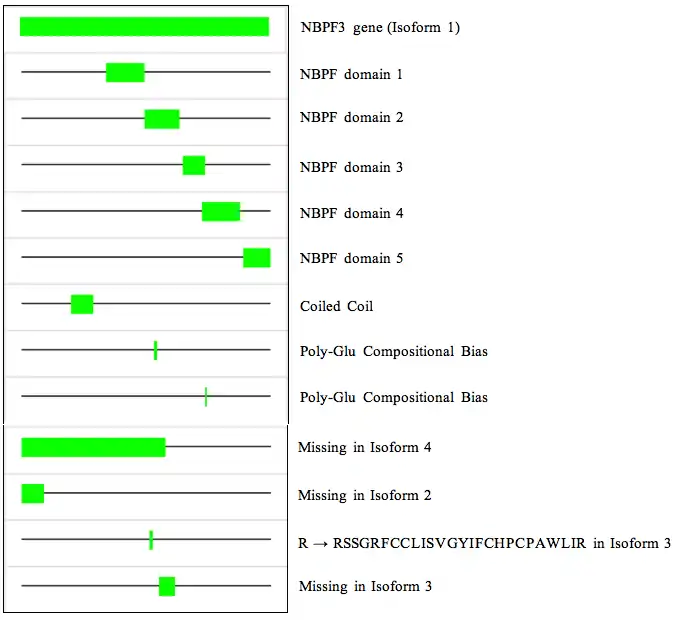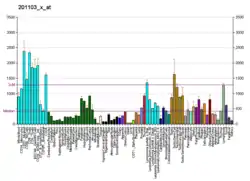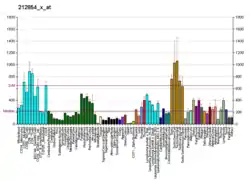NBPF3
Neuroblastoma breakpoint family, member 3, also known as NBPF3, is a human gene of the neuroblastoma breakpoint family, which resides on chromosome 1 of the human genome. NBPF3 is located at 1p36.12, immediately upstream of genes ALPL and RAP1GAP.[3]
| NBPF3 | |||||||||||||||||||||||||
|---|---|---|---|---|---|---|---|---|---|---|---|---|---|---|---|---|---|---|---|---|---|---|---|---|---|
| Identifiers | |||||||||||||||||||||||||
| Aliases | NBPF3, AE2, neuroblastoma breakpoint family member 3, NBPF member 3 | ||||||||||||||||||||||||
| External IDs | OMIM: 612992 HomoloGene: 88936 GeneCards: NBPF3 | ||||||||||||||||||||||||
| |||||||||||||||||||||||||
| |||||||||||||||||||||||||
| Orthologs | |||||||||||||||||||||||||
| Species | Human | Mouse | |||||||||||||||||||||||
| Entrez |
| ||||||||||||||||||||||||
| Ensembl |
| ||||||||||||||||||||||||
| UniProt |
| ||||||||||||||||||||||||
| RefSeq (mRNA) |
|
| |||||||||||||||||||||||
| RefSeq (protein) |
|
| |||||||||||||||||||||||
| Location (UCSC) | Chr 1: 21.44 – 21.49 Mb | n/a | |||||||||||||||||||||||
| PubMed search | [2] | n/a | |||||||||||||||||||||||
| Wikidata | |||||||||||||||||||||||||
| |||||||||||||||||||||||||
Protein sequence
The NBPF3 gene is 633 amino acids long and contains five DUF1220 domains, which are highlighted in the image below. DUF1220 domains are found in all other members of the neuroblastoma breakpoint family. The protein has a very repetitive structure, since, along with the remaining members of its protein family, it likely arose form segmental duplications on chromosome 1.

The domains are located at residues 236–298, 322–385, 394–460, 469–535, and 544–610.
The protein sequence is rich in three amino acids that are polar and negatively charged at physiological pH: glutamic acid, aspartic acid and glutamine. The isoelectric point of the protein is 4.21, the acidity of which may be attributed to the abundance of these amino acids.
Isoforms and sequence characteristics
There are four known isoforms of the NPBF3 gene. While isoform 1 is the dominant form of the gene, each other isoform has unique changes to the protein sequence that may affect the structure, expression or function of the gene product:[4]
| Isoform | Sequence Omissions | Sequence Additions | Length |
| 1 | - | - | 633 |
| 2 | 1-56 | - | 577 |
| 3 | 350-386 | 331 R→RSSGRFCCLISVGYIFCHPCPAWLIR | 621 |
| 4 | 1-358 | - | 275 |
These isoforms are represented in the following schematic, along with additional sequence characteristics which include Poly-Glu compositional biases and a potential coiled coil.

Function
The function of the neuroblastoma breakpoint family proteins, including NPBF3, is not yet understood by the scientific community. Because of the repetitive composition of this family of genes as well as their amplification in primates, it has been suggested that the family is involved in cognitive development and the evolution of primates.
It has also been suggested that there is a connection between the neuroblastoma breakpoint family and oncogenesis. Due to the up-regulation of NBPF genes in some tumor tissues, proteins of this family have been hypothesized to be oncogenes. It has also been suggested that members of the neuroblastoma breakpoint family are tumor suppressor genes, due to a loss of heterozygosity in tumor tissue in the region of chromosome 1 where NBPF3 and other NBPF proteins are located.[5]
Homology
Orthologs of NBPF3 are found primarily in primate species, though orthologous sequences can be found in cow, horse, and dog species. There is no mouse ortholog of NPBF3.
| Species | Organism common name | NCBI accession | Sequence identity | Sequence similarity | Length (AAs) | Number of DUF1220 domains |
| Homo sapiens | Human | CAB66824 | 100% | 100% | 633 | 5 |
| Pan troglodytes | Chimpanzee | XP_001163311.1 | 96% | 98% | 633 | 5 |
| Macaca mulatta | Rhesus macaque | XP_001114167.1 | 55% | 65% | 620 | 4 |
| Pongo albelii | Orangutan | NP_001127345.1 | 89% | 93% | 202 | 3 |
| Bos taurus | Cow | XP_611707.4 | 33% | 49% | 816 | 4 |
| Equus caballus | Horse | XP_001916030.1 | 37% | 55% | 1037 | 0 |
| Canis lupus familiaris | Dog | XP_540269.2 | 40% | 59% | 176 | 0 |
NPBF3 has many human paralogs because it is a member of a gene family.
| Species | Gene name | NCBI accession | Sequence identity | Sequence similarity | Length (AAs) |
| Homo sapiens | NBPF3 | CAB66824 | 100% | 100% | 633 |
| Homo sapiens | NBPF10 | NP_001034792.2 | 77% | 83% | 867 |
| Homo sapiens | NBPF1 | NP_060410.2 | 75% | 83% | 1214 |
| Homo sapiens | NBPF20 | NP_001032764.1 | 75% | 84% | 942 |
| Homo sapiens | NBPF8 | XP_001726998.1 | 75% | 84% | 3815 |
| Homo sapiens | NBPF16 | NP_001096133.1 | 75% | 84% | 670 |
| Homo sapiens | NBPF15 | NP_775909.1 | 75% | 84% | 670 |
| Homo sapiens | NBPF11 | NP_899228.3 | 75% | 83% | 790 |
| Homo sapiens | NBPF14 | NP_056198.1 | 74% | 83% | 921 |
| Homo sapiens | NBPF9 | XP_001717450.1 | 80% | 88% | 687 |
| Homo sapiens | NBPF7 | NP_001041445.1 | 69% | 79% | 421 |
| Homo sapiens | NBPF6 | NP_001137459.1 | 54% | 68% | 667 |
| Homo sapiens | NBPF4 | NP_001137461.1 | 53% | 67% | 638 |
| Homo sapiens | NBPF12 | XP_001715862.1 | 55% | 63% | 427 |
| Homo sapiens | NBPF5 | XP_001714524.1 | 60% | 73% | 428 |
Both orthologs and paralogs of NBPF3 were found using the databases BLAT.[6] and BLAST [7]
Protein interactions
NPBF3 interacts with three other proteins: C1orf19, ankyrin-1 (ANK1) and Ewing sarcoma breakpoint region 1 (EWSR1).[8] It is not known how these proteins interact or what the product of these interactions may be.
References
- GRCh38: Ensembl release 89: ENSG00000142794 - Ensembl, May 2017
- "Human PubMed Reference:". National Center for Biotechnology Information, U.S. National Library of Medicine.
- "Entrez Gene: NBPF3 neuroblastoma breakpoint family, member 3".
- "UniProt". Retrieved 14 May 2009.
- Vandepoele K, Van Roy N, Staes K, et al. (2006). "A novel gene family NBPF: intricate structure generated by gene duplications during primate evolution". Mol. Biol. Evol. 22 (11): 2265–74. doi:10.1093/molbev/msi222. PMID 16079250.
- "BLAT Search Genome". Retrieved 4 May 2009.
- "BLAST". Retrieved 4 May 2009.
- "STRING: Known and Predicted Protein-Protein Interactions".
Further reading
- Jöns T, Drenckhahn D (1998). "Anion exchanger 2 (AE2) binds to erythrocyte ankyrin and is colocalized with ankyrin along the basolateral plasma membrane of human gastric parietal cells". Eur. J. Cell Biol. 75 (3): 232–6. doi:10.1016/s0171-9335(98)80117-9. PMID 9587054.
- Hartley JL, Temple GF, Brasch MA (2001). "DNA cloning using in vitro site-specific recombination". Genome Res. 10 (11): 1788–95. doi:10.1101/gr.143000. PMC 310948. PMID 11076863.
- Wiemann S, Weil B, Wellenreuther R, et al. (2001). "Toward a catalog of human genes and proteins: sequencing and analysis of 500 novel complete protein coding human cDNAs". Genome Res. 11 (3): 422–35. doi:10.1101/gr.GR1547R. PMC 311072. PMID 11230166.
- Strausberg RL, Feingold EA, Grouse LH, et al. (2003). "Generation and initial analysis of more than 15,000 full-length human and mouse cDNA sequences". Proc. Natl. Acad. Sci. U.S.A. 99 (26): 16899–903. Bibcode:2002PNAS...9916899M. doi:10.1073/pnas.242603899. PMC 139241. PMID 12477932.
- Ota T, Suzuki Y, Nishikawa T, et al. (2004). "Complete sequencing and characterization of 21,243 full-length human cDNAs". Nat. Genet. 36 (1): 40–5. doi:10.1038/ng1285. PMID 14702039.
- Petroziello J, Yamane A, Westendorf L, et al. (2004). "Suppression subtractive hybridization and expression profiling identifies a unique set of genes overexpressed in non-small-cell lung cancer". Oncogene. 23 (46): 7734–45. doi:10.1038/sj.onc.1207921. PMID 15334068.
- Wiemann S, Arlt D, Huber W, et al. (2004). "From ORFeome to biology: a functional genomics pipeline". Genome Res. 14 (10B): 2136–44. doi:10.1101/gr.2576704. PMC 528930. PMID 15489336.
- Vandepoele K, Van Roy N, Staes K, et al. (2006). "A novel gene family NBPF: intricate structure generated by gene duplications during primate evolution". Mol. Biol. Evol. 22 (11): 2265–74. doi:10.1093/molbev/msi222. PMID 16079250.
- Rual JF, Venkatesan K, Hao T, et al. (2005). "Towards a proteome-scale map of the human protein-protein interaction network". Nature. 437 (7062): 1173–8. Bibcode:2005Natur.437.1173R. doi:10.1038/nature04209. PMID 16189514.
- Mehrle A, Rosenfelder H, Schupp I, et al. (2006). "The LIFEdb database in 2006". Nucleic Acids Res. 34 (Database issue): D415–8. doi:10.1093/nar/gkj139. PMC 1347501. PMID 16381901.
- Vandepoele K, van Roy F (2007). "Insertion of an HERV(K) LTR in the intron of NBPF3 is not required for its transcriptional activity". Virology. 362 (1): 1–5. doi:10.1016/j.virol.2007.01.044. PMID 17391723.




